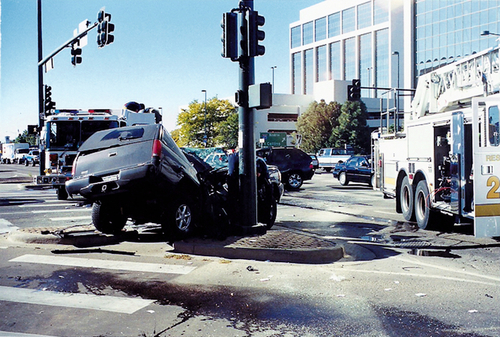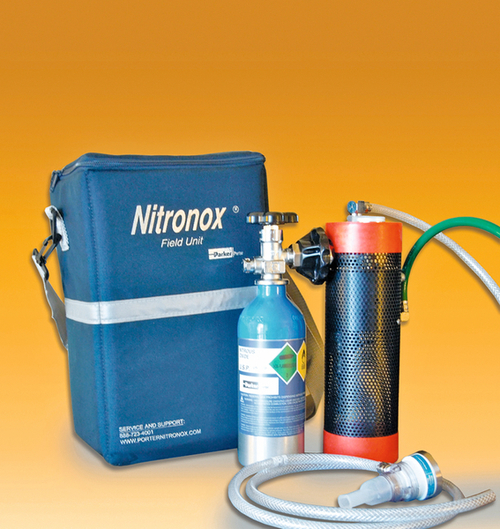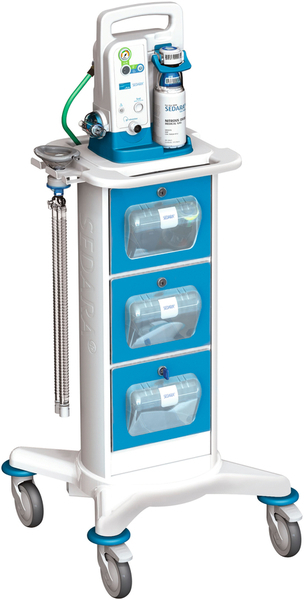Multidisciplinary Application of N2O/O2 Sedation
CHAPTER OBJECTIVES
Upon completion of this chapter, the reader should be able to:
1. Appreciate the myriad of disciplines using N2O/O2 sedation for patient care and treatment.
2. Recognize how N2O/O2 sedation can be used for a wide variety of procedures.
Some health disciplines have been using N2O/O2 sedation for mild-to-moderate pain control and anxiety relief for many years. Other healthcare professionals have recently revisited its use, not as a general anesthetic but as an effective analgesic-sedative for the many ambulatory procedures being performed today.
Articles referring to N2O/O2 sedation in obstetrics are found in the literature because of long-standing use in Great Britain.1 Emergency care personnel, in both the field and the hospital setting, have also been long-term providers of this therapy.2 Other disciplines have limited literature citations.
N2O may have broad applicability in an era in which greater numbers of surgical procedures are being performed in outpatient settings. N2O/O2 sedation is a viable treatment alternative for outpatient procedures in a variety of disciplines.
1 Emergency Medicine
A. Prehospital Care in the Ambulance
1. An analgesic agent appropriate for prehospital emergency pain control should possess several specific characteristics. Properties that are desirable are rapid onset of clinical action, no effect on level of consciousness, no significant side effects, and no masking of other conditions, which would ultimately interfere with the diagnostic evaluation at the hospital.
2. N2O possesses most of these characteristics. Several researchers support the notion that N2O possesses many of the ideal characteristics necessary in this discipline.3–5
3. Historical use of N2O/O2 in emergency medicine. The first self-administered, fixed-ratio system used in an ambulance service was implemented by Peter Baskett, from England, in 1969. A mixture of 50% N2O and 50% O2 was delivered to the patient by use of an on-demand system. His idea was that patients in an ambulatory situation should control their own sedation by self-administering this fixed-ratio mixture of gases. Baskett concluded his clinical trials (305 patients with significant decrease in pain and no serious complications) with the claim that N2O/O2 was safe and effective for use in emergency medicine.2
4. Current usage and effectiveness statistics
a. Recently, emergency medical services (EMS) have placed priority on early patient stabilization, safe transportation, and effective communication systems (Figure 14-1).
b. Great strides have been made in these areas, making services to the public safer and more effective. Pain control has always been a focus and is gaining greater attention. The issues of masking symptoms or making conditions worse before hospital access are important considerations in the decision to attend to pain with an analgesic agent.
c. EMS personnel continue to use Baskett’s fixed-ratio, self-administration technique. This technique is popular because of its portability in the field. Emergency departments in hospital settings may use the fixed-ratio, on-demand equipment, or they may use continuous-flow machines like those that have been used in dentistry.
d. Faddy and Garlick completed a systematic review of the literature regarding prehospital treatment of patients with a 50%/50% N2O and O2 mixture.6 Their review analyzed adverse events, recovery time, and need for additional medication.6 They concluded that because of a low incidence of reported adverse events, N2O and O2 could be safely administered by lay responders.6
B. Use in Hospital Emergency Departments
1. Not long after the initiation of prehospital sedation in England, healthcare providers in the United States began to use it for emergency medicine in the hospital. In 1979, Flomenbaum and colleagues7 were the first to promote its use in U.S. emergency departments and to document such use in the literature.
2. Researchers have cited many instances of successful uses of N2O/O2 in emergency department settings.3–5,8,9 Gamis and colleagues10 completed a study that used N2O/O2 on pediatric patients requiring laceration repair in the emergency department at Children’s Mercy Hospital in Kansas City, Missouri. Thirty-four children participated and were placed in either a treatment group that used a ratio of 30% N2O and 70% O2 or a control group that used 100% O2. A clinically significant difference was found in the pain scores between groups of children older than 8 years. Although no statistically significant difference was found with children in the 2- to 7-year-old age group, pain scores decreased when N2O/O2 was used.10 In other studies, N2O/O2 provided a significant reduction in pain and anxiety during venous cannulation in the emergency department.11,12 The New York Hospital Queens are seeing fewer children in distress in their pediatric emergency department since nitrous oxide/oxygen sedation was implemented.13
3. White and colleagues14 confirmed that prehospital pain control can be improved, especially for patients with extremity fractures. They acknowledge N2O as a viable option. Orthopedic fracture care in the emergency department of a hospital has also shown success with nitrous oxide and oxygen.15,16
4. When providing patient care of the skin, N2O/O2 may be used when placing and removing sutures; incising abscesses; removing cysts, nevi, or warts; débriding wounds; and dressing burns.
5. Head injuries that are nonneurologic in origin may be successfully treated with N2O/O2. Examples are débriding abrasions, removing or draining abscesses or cysts, removing foreign objects from ears, and removing or replacing teeth after trauma.
6. Examples of other procedures include removing or changing drains; performing catheterizations, biopsies, splinting, extrications, and complicated transfer or movement of patients; and treating other musculoskeletal injuries, including strains, sprains, and dislocations.
7. An updated review of the literature indicates continuing support for use of N2O/O2 sedation in emergency medicine.17–21
C. Contraindications for Use of N2O/O2 in Emergency Medicine
1. In emergency cases in which a pneumothorax or a closed head injury is suspected, N2O is not recommended.10
D. Equipment
1. The equipment used in ambulances consists of the gas mixture stored either in a single cylinder or in separate tanks. In some countries, the single-cylinder system is preferred because it is lightweight and easy to operate. A major disadvantage of this 50:50 mixture is the instability of the gases in one cylinder. If the temperature of the mixture is allowed to fall below 5.5° C for even a limited amount of time, the N2O separates and settles at the bottom of the cylinder. A high concentration of O2 could be dispensed under these conditions, which would mean that pure N2O would be dispensed as the O2 is depleted.
2. This system is popular in countries such as the United Kingdom, Canada, Australia, and New Zealand.
3. Porter Instrument Co.—A Division of Parker Hannifin, offers the safety of a double-tank system both in a portable field-unit option as well as in a unit designed for a hospital or other medical setting. The bag unit weighs approximately 10 pounds and can be carried over the shoulder or harnessed to the back. The Nitronox field model is shown in Figure 14-2.
4. As demand-flow units, patients are required to hold a mask and place it over their mouth and nose to inspire the gas. If the patient is unable to hold the mask because of an injury, a mouthpiece can be held tight between the lips and teeth, allowing for inspiration through the mouth.
5. The SEDARA® gas mixer system is a portable medical device debuting from Linde Therapeutic Solutions. This demand-flow system is intended to support short, planned, or emergent clinical procedures outside the operating room (see Figure 14-3).
E. Products
1. The 50:50 gas mixture that is primarily used in the United Kingdom, Canada, and Australia is called Entonox. It is manufactured by several companies.
2. Nitronox is available in both the United States and abroad and is manufactured by Porter Instrument Co.—A Division of Parker Hannifin.
2 Obstetrics and Gynecology
A. Labor and Delivery
1. The literature is saturated with studies reporting manageable, successful labor and deliveries with N2O/O2 therapy.
2. A Russian physician began the use of N2O/O2 in 1880 as an analgesic during labor. His experiments led to the conclusion that it relieved labor pain without harming mother or baby.22
3. Swedish literature citations confirm the safety record of N2O anesthesia. Records show no reproductive problems in nearly 300 women exposed to N2O.23
4. A 1981 hospital study in Wales evaluated the effectiveness of Entonox delivered through a nasal catheter to women in labor. Both midwives and mothers agreed that Entonox provided labor pain relief.24 Administration by nasal catheter was comfortable and nonintrusive; however, this method of delivery should not be used because of environmental contamination.
5. A 1994 study in Toronto done by Carstoniu and colleagues25 raised questions about the validity and reliability of previous research on N2O/O2 use in labor, citing methodologic flaws as the primary weakness of early research. In the study, relief of pain and improvement of oxygen saturation were the foci. Results showed no statistical difference when patients used N2O/O2 or compressed air. Patients did recognize the difference in gases, and when offered to continue either, they preferred N2O/O2. The oxygen desaturation factor was insignificant, and authors indicated O2 levels were enhanced between contractions.20 However, Fortescue and Wee26 offered that distraction, relaxation, and control may be reasons why the other researchers did not achieve statistical significance between nitrous oxide and air.
6. Vallejo and colleagues27 reported 40% nitrous oxide was effective in anxiety reduction during cesarean section at the time of injection and incisions.
7. Support for the use of N2O/O2 for labor and delivery continues.28–32 It was deemed effective by Klomp and colleagues in a 2012 systematic review investigating inhaled analgesia for pain management in labor published in the Cochrane Database of Systematic Reviews.28 It is presented positively by Rooks in a review of the literature as well.29 It is touted as “appealing, effective, safe, and most useful” in a pilot study at a low-income hospital setting.30 This option is being utilized successfully in the UCSF Birthing Center and able to be administered by midwives.31
B. Gynecologic Laparoscopy
1. Although CO2 is used traditionally as the insufflation gas for laparoscopy, N2O may be used as part of a combination technique.
2. The American Association of Gynecologic Laparoscopists33 stated that no adverse incidents occurred in more than 20,000 procedures when N2O/O2 was used in some capacity.
3 Dermatology
A. There are many potential indications for N2O/O2 use in dermatology. Drosner indicated it was used during 46 procedures ranging from wrinkle reduction to work with tattoos, scars, and pigmentation. The end result was positive for patients and practitioners.34
B. Hair Transplantation
1. Hair transplantation is cited as a procedure in which N2O/O2 can provide satisfactory analgesia without negatively affecting patient cooperation or producing untoward side effects. Patients in a study by Sadick and Militana35 responded overwhelmingly (94%) that they preferred N2O/O2 over 10 mg of diazepam (Valium) and the Dermojet method of lidocaine delivery. Because this surgery requires repeated injections of local anesthetic, the analgesic/sedative nature of N2O/O2 allows for increased patient tolerance.
2. An N2O/O2 advantage noted in hair transplantation is the rapid elimination of the drug versus others, such as diazepam, which has a much longer latent period without reversal.23
C. Skin treatments and cancer surgeries are also mentioned in the literature as being facilitated by N2O/O2 sedation.35,36
D. Cosmetic Surgery—Tumescent Liposuction
1. Local anesthetic infiltration has been combined with intramuscular (IM), intravenous (IV), inhalation sedation, or general anesthesia for this procedure. Professionals state that although many drugs interact with local anesthetics required by this procedure, N2O/O2 does not.37
2. Bird and Albert reviewed the literature and concluded N2O/O2 could be considered as an effective adjunct for this procedure.38
E. Dermatologists’ experience with N2O/O2 is minimal; however, they support its adjunctive properties to local anesthetics.37 Maloney and colleagues39 concur with others in the dermatology field who support the use of N2O/O2. In their study, 46 of 47 patients indicated that they would request N2O/O2 for future visits and thought it should be used more in the discipline.39
4 Podiatry
A. Ambulatory Foot Surgeries
1. Ambulatory foot surgery was successfully accomplished in 1966 with N2O/O2 sedation. It was the first mention in the literature of N2O/O2 use in this discipline.40
B. Various Other Podiatric Procedures
1. In a 1972 study, Mosher and Sorkin41 provided descriptive evidence of 21 patients requiring varying podiatric procedures while receiving N2O/O2 titrated to appropriate levels. No significant side effects were noted; amnesia was reported in 19% of patients. All patients indicated a relaxed sense of well-being. Several advantages of N2O/O2 analgesia were listed, one of which was the enhancement of local anesthetic effects.
2. Some of the procedures reported being performed with N2O/O2 are digital arthroplasty, nail matricectomy, subungual exostosectomy, bunionectomy, excision of digital mass, digital arthrodesis, excision of hallux ossicle, tailor’s bunionectomy, and excision of plantar mass.41
C. Use with Diazepam (Valium)
1. Another study performed by Harris and colleagues in 1982 encouraged specialists to use N2O/O2 with 10 mg of diazepam. The authors stated success in more than 150 cases. Their attitude regarding this technique is professed as “a new era in the attainment of near-painless podiatric surgery.”42
5 Ophthalmology
A. Eye Surgery
1. The most common anesthetic techniques involve IV sedation and retrobulbar block or topical anesthesia only. Cataract surgery with N2O/O2 sedation is referenced in the journal Ophthalmic Surgery.43
2. N2O/O2 can be used instead of IM premedication to prepare patients for the necessary local anesthetic placement. McMahan43 used N2O/O2 therapy on 800 patients for cataract surgery with great success.
B. Implant Surgery
1. Implant surgery performed at the Hawaiian Eye Surgicenter includes N2O/O2 as part of the procedure. Clinicians at this surgery center wanted an analgesic-sedative for assistance during the local injection but did not want the prolonged effects of other drugs. They wanted patients to be fully recovered for prompt dismissal.
2. Clinicians expressed satisfaction with the calming, amnestic effects with their 50% N2O and 50% O2 technique.44
C. Ambulatory setting. Specialists in the ophthalmology discipline acknowledge interest in the use of N2O/O2 sedation in the ambulatory setting.45
6 Cryosurgery
A. In cryosurgery, N2O is used to cool metal instruments, which in turn initiates the freezing or tissue necrosis of a lesion.
B. N2O is preferred over liquid nitrogen because it is easier to handle.46,47
C. Successful management of obstructive malignant airway lesions and early superficial lung cancer with bronchoscopic cryotherapy was shown by Noppen and colleagues48
Stay updated, free dental videos. Join our Telegram channel

VIDEdental - Online dental courses





